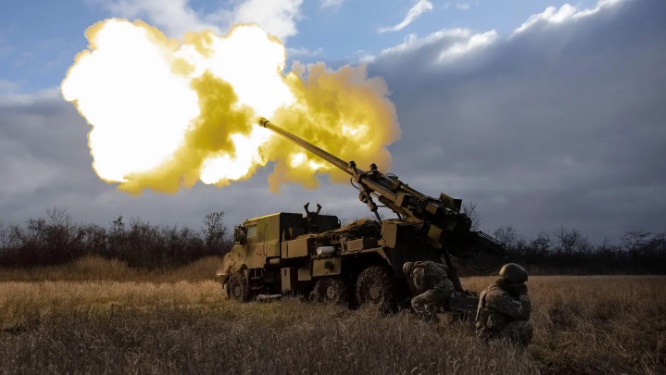
ScienceHunter Ред. 23.11.2023
New Technologies Could Help Resolve Ukraine’s Artillery Challenges

In a recent interview with The Economist, General Zaluzhny, the Commander-in-Chief of the Armed Forces of Ukraine, discussed the challenges faced by Ukrainian forces which have ultimately resulted in a stalemate with Russia.
He emphasized that many of these issues are linked to artillery, highlighting that the Russian military presently holds a tactical advantage in that field. The Russians achieved this advantage by fielding new technologies that allow them to precisely hit Ukrainian targets while also limiting the effectiveness of Ukrainian artillery. He stressed the need for Ukraine to develop and deploy their own advanced technologies to regain the upper hand in the war.
Artillery, historically termed the "king of battle" by Napoleon, remains the fundamental component within both Russian and Ukrainian military units, a legacy of Soviet doctrine. Indeed, this doctrine assigns the task of destroying enemy forces to the artillery. Meanwhile, the infantry and armor units protect the artillery units and shape the battlefield to allow the artillery to more easily engage targets. Tied in with the artillery are counter-battery units, which identify the origin of an incoming round, which the artillery can then target, hence destroying the enemy’s artillery assets. Further, modern artillery now includes precision rounds that correct their flightpaths to strike a target and loitering munitions, commonly referred to as “kamikaze drones.”
The conflict between Ukraine and Russia has witnessed the introduction of numerous new technologies, and many of these systems directly impacted artillery operations. General Zaluzhny identified several Russian advancements as a source of problems for Ukrainian forces. Specifically, the Russians have found success with their Lancet loitering munition. These highly accurate and compact drones are difficult to detect and operate on an unpredictable flight path, hampering Ukrainian counter-battery efforts. Additionally, the Russian Pole-21 electronic warfare system jams the GPS-signals necessary for the Excalibur rounds fired by the Ukrainians. This results in the rounds veering off their intended course and not striking their target.
Ukraine has already begun adjusting its artillery tactics to incorporate technologies comparable to those used by Russian forces. For instance, Ukraine has been using loitering munitions against the Russians, including American Switchblades and Polish Warmates, both of which have capabilities comparable to the Russian Lancets. Additionally, Ukraine has received a number of electronic warfare systems in foreign aid packages, which would likely include GPS spoofing and signal jamming, which would disrupt Russian drones and precision rounds. Nevertheless, there exists an ongoing technological evolution on both sides, with the Russians likely already developing countermeasures against the electronic warfare systems and loitering munitions used by Ukraine.
To break the current deadlock, General Zaluzhny stressed the need of developing and fielding new technologies. As Ukraine attempts to evolve their artillery systems, they have the potential to leverage advances from the commercial sector. Generally, the Ukrainians have the potential to better leverage commercial technology than the Russian military, which has a rigid acquisition process built on a complex defense industrial base. However, the Ukrainians have had limited success thus far in militarizing commercial systems, as can be seen from the Russians electronic warfare systems taking down large numbers of commercial drones used by the Ukrainians.
Regardless, Ukraine has both the intellectual capital and the military prowess to militarize commercial technology, especially those related to artificial intelligence (AI). In recent years, the commercial sector has seen a significant surge in the adoption of AI, revolutionizing various industries due to its ability to enhance efficiency and decision-making processes. In an artillery context, AI has the potential to be a useful tool, reducing the time required to target enemy forces while also making the rounds more accurate and resilient. Further, the use of AI can increase drone autonomy allow missions to persist even when control signals are jammed. Moreover, it could allow drones and precision rounds to be less reliant on GPS, instead allowing for tools such as vision-based navigation.
A crucial aspect of AI in the future of artillery lies in computer vision, which enables machines to interpret and understand visual information. Computer vision involves teaching computers to process images and videos, enabling them to recognize patterns, objects, and make decisions based on visual data. Incorporating computer vision into artillery practices could provide Ukrainian forces with a significant advantage, especially due to the distinct and easily recognizable "Z" emblem on Russian military equipment. This emblem, unique to Russian vehicles and not in the Cyrillic alphabet, can be efficiently detected by computer vision systems allowing the Ukrainians to pinpoint Russian equipment.
By integrating computer vision into their artillery strategies, Ukrainian forces have the potential to overcome many of the challenges outlined by General Zaluzhny. Simplified drones capable of flying without GPS could autonomously detect Russian equipment and transmit an image and their position back to the control station. The Ukrainian forces could fire a loitering munition, which would take a safe flight path to the Russian target, recognize the target, crash into it, and detonate. This approach bypasses GPS reliance and reduces communication between operators and drones, thereby mitigating the impact of Russian electronic warfare equipment.
The ongoing conflict has witnessed a technological arms race, with both sides striving for an advantage, especially in the field of artillery. Russia currently has an edge through their use of advanced technologies, leading to the current stalemate. For Ukraine to regain the edge, they will need to evolve their artillery equipment and tactics as well, likely through the use of commercial technologies. At that point, the Ukrainian forces would be one step closer to breaking the stalemate.